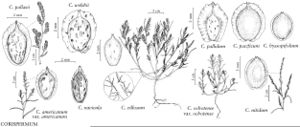Corispermum pacificum
Novon 5: 345, fig. 1A. 1995.
Plants usually branched from base, (5–)15–40 cm, glabrous or sparsely covered with dendroid hairs (especially when young). Leaf blades narrowly lanceolate, linear-lanceolate, or linear, flat or nearly so, 2–5(–7) × 0.2–0.6 cm. Inflorescences usually compact, rather dense, or sometimes ± lax, condensed only near apex, ovoid, oblong-ovate, obovate, broadly linear, or occasionally clavate. Bracts ovate-lanceolate, narrowly ovate-lanceolate, almost ovate, or lanceolate, (1–)1.5–2.5 × 0.3–0.7(–0.9) cm. Perianth segment 1, sometimes absent in distal flowers. Fruits usually black (rarely deep olive green, especially when immature), sharply contrasting with greenish semitransparent wings, without spots and warts, slightly convex abaxially, flat or slightly concave adaxially, orbiculate-obovate to almost orbiculate, broadest near middle (or occasionally slightly beyond), 3–4 × 2.7–3.8 mm, shiny; wing translucent, thin, (0.2–)0.3–0.6 mm wide, margins slightly undulate or indistinctly erose-denticulate, apex rounded or occasionally indistinctly notched.
Phenology: Flowering late summer–fall.
Habitat: Sandy shores, dunes
Elevation: 0-500 m
Distribution

Idaho, Oreg., Wash.
Discussion
Of conservation concern.
Corispermum pacificum seems to be closely related to Siberian C. crassifolium Turczaninov and C. maynense Ignatov. The latter species occurs in the northeastern Russian Far East and may be expected to occur in Alaska. Corispermum pacificum differs from C. maynense by its usually more robust habit, and its wing rounded (rarely rounded-truncate or indistinctly emarginate, but not triangular) at apex. From C. crassifolium it may be distinguished by the constant presence of perianth segments, and more flattened black mature fruits. Corispermum pacificum probably also occurs in adjacent regions of British Columbia. Corispermum pacificum is placed in subsect. Crassifolia (S. L. Mosyakin 1997). This subsection seems to be of Siberian origin, with its central species, C. crassifolium, being closest to the hypothetic ancestral taxon. The presence of perianth segments in C. pacificum may be explained by ancient hybridization with representatives of subsect. Pallasiana.
Reproductive isolation between the sympatric species of Corispermum may be achieved by different flowering periods. Occasional hybrids between C. pacificum and C. villosum are similar in their habit to C. pacificum in having usually broad leaves and rather dense inflorescences but they have mostly aborted fruits suggesting that C. pacificum and C. villosum are taxonomically distant species.
Selected References
None.
